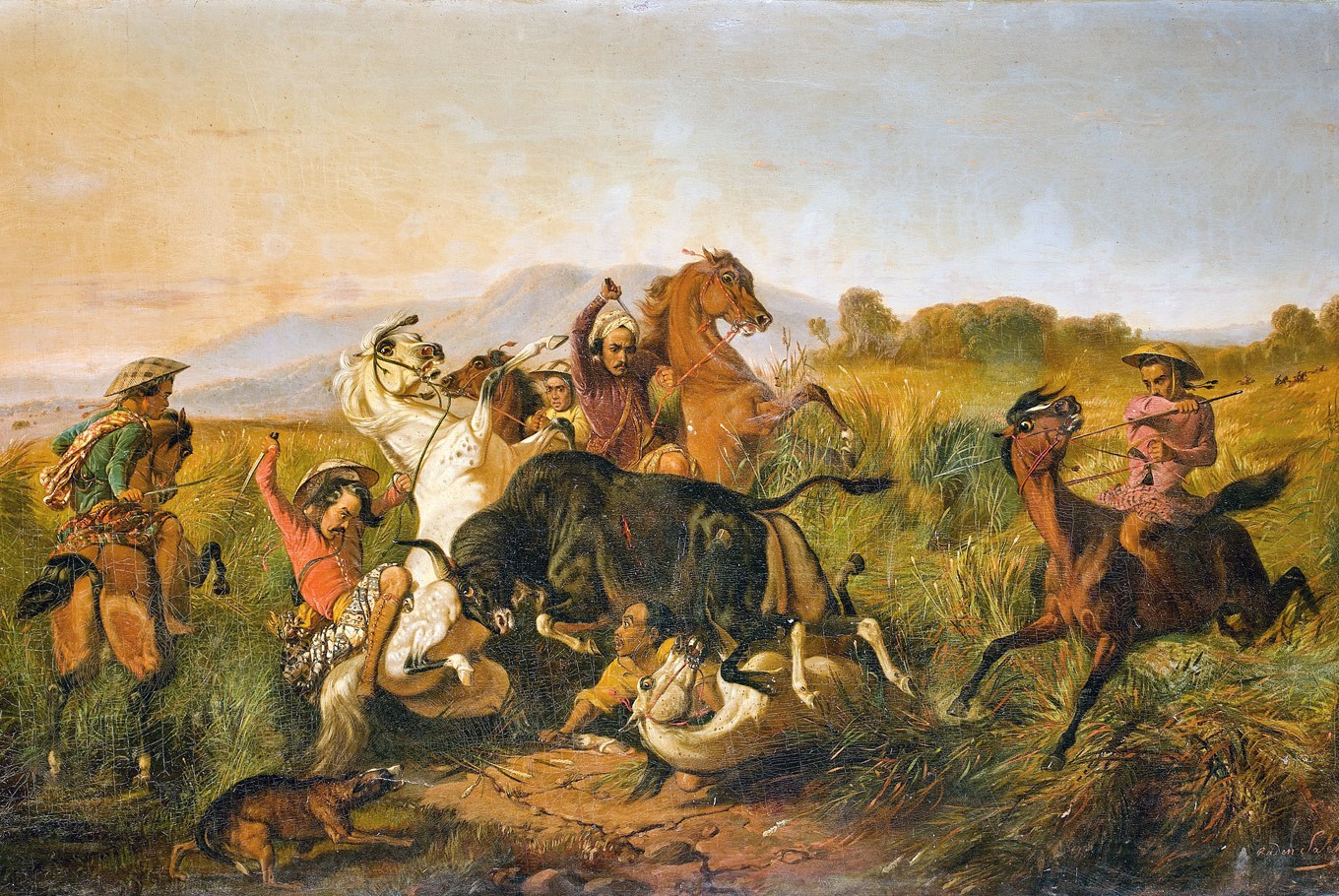Popular Reads
Top Results
Can't find what you're looking for?
View all search resultsPopular Reads
Top Results
Can't find what you're looking for?
View all search resultsThe wild animals of Raden Saleh
The paintings of Raden Saleh Syarif Bustaman (1807-1880) have received great attention in the past 25 years and been held in high regard in fine art circles.
Change text size
Gift Premium Articles
to Anyone
I
n January, a painting by Raden Saleh titled Perburuan Banteng (Banteng Hunt) was purchased by an anonymous buyer at the hammer price of €7.2 million (US$8.8 million) during an auction in Vannes, France, making it the most expensive Indonesian artwork in the market.
“With a premium fee, €8,928,000 [Rp 146 billion] was paid for the painting,” auctioneer Jack-Phillipe Ruellan said.
The work was initially offered at €200,000 and was estimated to fetch €1 million prior to the auction.
The paintings of Raden Saleh Syarif Bustaman (1807-1880) have received great attention in the past 25 years and been held in high regard in fine art circles. It began when several international auction houses like Christie’s and Sotheby’s managed to sell Saleh’s works at high prices in Singapore and Hong Kong, so, henceforth, wherever his paintings were found, they were brought to the forefront.
A National Gallery Singapore exhibition titled Between Worlds: Raden Saleh and Juan Luna, which is displaying 50 paintings from Saleh until March 11, is an example of appreciation for the works of the artist.
The visual arts community considers Saleh’s portraits and sea and mountain landscape paintings appealing. However, for many, his most fascinating works bear the theme of wildlife and are immersed in the feeling of chaos.
In his youth, Saleh lived in Buitenzorg (Bogor, West Java), near Hortus Bogorienses (Bogor Botanical Gardens). He developed skills in art from landscape painters AJ Bik and AAJ Payen, both of whom often used elements of nature in their works.
In 1829, Saleh was assigned to accompany financial inspector JB de Linge to Antwerpen, Holland. Living in a country with a tradition of art, he felt very happy. So when Linge returned to the Dutch East Indies, Saleh chose not to return home. He used the excuse that he wanted to learn arithmetic, but he was in fact absorbed in painting. He later moved to The Hague and learned about landscape painting from Andreas Schelfhout and portrait painting from Cornelis Kruseman.
One day, Saleh met Piere Henri Martin, a circus animal tamer who nurtured Saleh’s love of animals and encouraged him to observe their behavior, body contours and facial features. He studied animal temperaments from library books and grew fond of strong and wild animals like horses, lions, tigers and bulls. Saleh then painted the animals on his canvases in 1840, at first in portrait form and often times in close-ups.
Some of his fans suggested that Saleh visit Algeria to observe animal behavior in the wild, which he did. He compared himself to French artist Eugene Delacroix, an idol of his who also explored Algeria when looking for inspiration to paint predatory animals.
During his travels, Saleh visited the studio of famous French painter Horace Vernet (1789- 1863), also a fervent animal painter. There, he found Vernet’s Mazeppa, a 1826 work depicting a man fastened to a galloping white horse followed by a wolf.
Several years later the painting took a lithographic form and was widely disseminated, which encouraged Saleh to create an adaptation with a dramatization of chaos. So he created the painting Penunggang Kuda dari Arab Diterkam Singa (Arab Horseman Attacked by a Lion) in 1842.
The painting depicts a horseback rider trying to save himself from a lion’s attack. The story of an Arab confronting a lion is also shown in Perkelahian dengan Singa (Fighting Against a Lion, 1870), which later went to the Indonesian Presidential Palace’s collection.
Dozens of Saleh’s works represent the dramatic relationship between human and animal, as depicted in fights between animals, animal hunts by humans, animals threatining humans or the use of animals by humans to kill other animals. The scenes tend to be terrifying, but all of them are elegantly presented.
This style is presented in many of his works for two reasons. First, animals awed him, and second, many collectors ordered such paintings.
Saleh’s high-quality works were priced lower by European standards because they were categorized as art from an Eastern painter belonging to the Dutch East Indies’ Inlander — a derogatory term used to describe the archipelago’s indigenous people.
Saleh also frequently painted Arab men because he was of Arab descent. His father was Sayid Husen bin Alwi bin Awal and his mother came from Javanese nobility.
One of his lauded paintings imbued with chaos is Antara Hidup dan Mati (Between Life and Death), which was exhibited at the Louvre in Paris in 1931. This large-sized work was reduced to ashes when the museum caught fire that year. Fortunately, it was already lithographically reproduced by CW Mieling for visual scrutiny.
Saleh’s paintings of the harshness of the natural world have continued to arouse art aficionados today, making his works under this theme more expensive in the auction market.
Your Opinion Matters
Share your experiences, suggestions, and any issues you've encountered on The Jakarta Post. We're here to listen.
Thank you
Thank you for sharing your thoughts. We appreciate your feedback.











